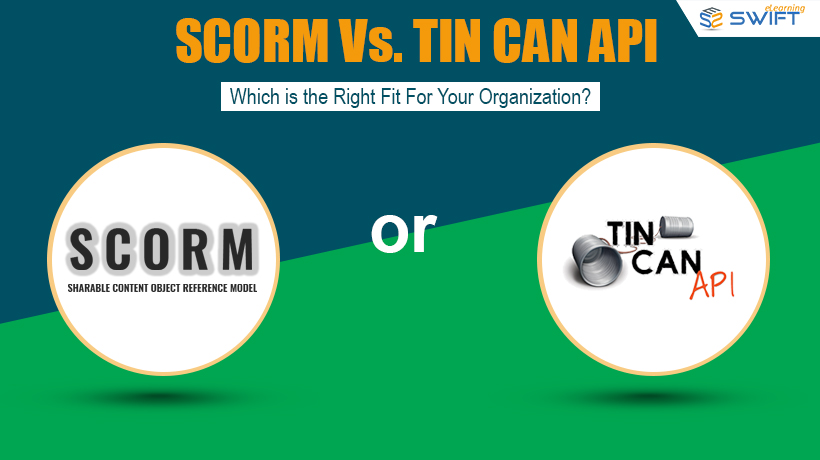What is SCORM?
SCORM is a set of standards for eLearning content that ensures compatibility and interoperability, allowing online courses to be easily shared across different learning platforms.
What is Tin Can API, xAPI or Experience API?
Tin Can API, xAPI or Experience API, is a technology that tracks and records learning experiences, providing a more comprehensive and versatile approach to learning data than traditional eLearning standards.
Creating eLearning content is not enough, it also needs to be well tracked, recorded and analyzed to measure the learning via Learning Management System (LMS).
It only happens when the developed content adheres to set of technical standards such as SCORM or Tin Can API.
So choosing an apt platform to publish the eLearning courses must be well thought out.
While selecting the compliance there is a slight confusion between eLearning content standards SCORM and Tin Can API a.k.a. xAPI (Experience API).
In this blog, we will explore the facts to help you understand the differences between these two and help you make the right decision that fits your eLearning requirement.
SCORM Vs. Tin Can API
One of the important peculiarities among SCORM and Tin Can is that they are different standards. Though their basic job is to define how the eLearning courses communicate with a Learning Management System (LMS). It’s just that both of these platforms do the same job in different ways.
And obviously since Tin Can is the successor of SCORM, it can do a lot more than what SCROM does. We’ll get to Tin Can in a moment, but before that let’s see what SCORM has for us to offer.
SCORM (Sharable Content Object Reference Model)
SCORM (Shareable Content Object Reference Model) was introduced in 1999 developed by U.S government. SCORM refers to a set of technical standards for packaging the eLearning content you want to share across different LMSs.
For more information on SCORM you can go through our blog “All You Need to Know about SCORM and LMS”.
Key Features of SCORM:
Interoperability: SCORM ensures that content created on one SCORM-compliant platform can be used seamlessly on another.
Tracking and Reporting: SCORM allows detailed tracking of learner progress, completion, and assessment scores.
Sequencing: It enables the organization of learning content in a sequential manner, controlling the flow of the course.
Tin Can (xAPI)
Tin Can Experience API or xAPI has been one of the hot trends in eLearning recently. Tin Can was officially released as version 1.0 in April 2015. Apart from packaging and presenting content and marking courses as complete or pass or fail, the Tin Can API does many more things.
Tin Can portrays much detailed view of learner progress going inside out of traditional learning environment both online and offline. It enables you collect valuable data both inside and outside of an LMS addressing the critical needs of organizations and provides the scope for mobile learning, collaborative learning, offline learning.
Want to know more about Tin Can completely then have a glance at our blog “Things you didn’t know about Tin Can API (xAPI, Experience API)”
Key Features of Tin Can API (xAPI):
Broad Learning Data: xAPI captures a diverse range of learning experiences, including offline and mobile learning, simulations, and real-world activities.
Real-Time Tracking: It allows real-time tracking of learning activities, providing instant insights into learner behavior.
Flexibility: xAPI is not confined to a specific platform, allowing organizations to collect data from various sources beyond traditional LMS.
Advantages of Tin Can over SCORM:
1. With integration of LRS you can take full advantage of xAPI’s reporting power.
2. Tin Can allows you to track learning content beyond LMS.
3. Tracks varied learning types such as blended learning, gamification, simulations and so on blended learning.
4. Integrating Tin Can conformant systems is faster and cheaper compared to SCORM
5. Tin Can provides more effective learning solutions in designing innovative and engaging experiences as it makes better usage of newer technologies
Verdict
Well, after reading the above lines you will surely have this question in your mind “Should we switch to Tin Can API at our organization?”
There isn’t a distinct answer for this question as it all depends on what kind of information you’re trying to get. If your organization doesn’t adopt mobile learning or you might not want to track variety of learner data then SCORM would suffice your needs. But if you are large organization and are interested in collecting a rich variety of data about your learner base and use mobile learning, you must leverage Tin Can to reap the maximum benefits.

